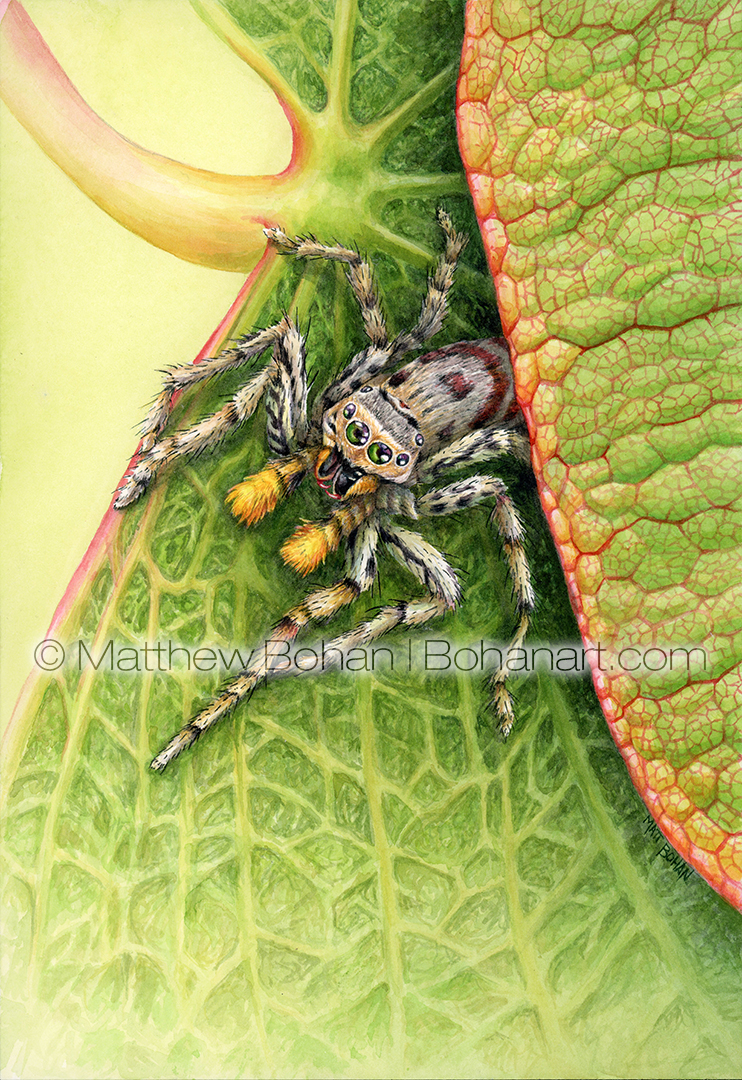

Jumping spiders have fascinated me since I was a little kid. My brothers and I would find several varieties of them on a retaining wall near the swimming pool that we frequented in the summer. That made the seemingly endless “Adult Swim” sessions go by a little faster while we waited for the octogenarians to finish soaking their copious liver spots.
Honestly, looking for jumping spiders was the runner-up to our all-time favorite adult swim time-burner… the towel fight. This event usually featured my brothers and one cousin. Other kids occasionally joined in, but for some reason they never seemed to come back. “Normal” participants would simply twirl a towel around and go about snapping the twisted towel at each other. Our version was much more Lord of the Flies. There was a long and elaborate folding process involved in wrapping the perfect whip-like towel. Each kid seemed to have their own idea of what was the best method. My brother Ted was the undisputed champion. He even generously showed me how he transformed his towel into a world-class weapon. I think that deep down he knew I wasn’t a threat, because I’d never have the patience or dexterity to painstakingly fold, then slowly and tightly compress while accurately twisting a towel into what ended up looking like, acting like and sounding like a bullwhip. Most participants’ towels lost their compression and strength after a dozen shots, but Ted’s would never fade during the call of duty.
Towel fights were strictly forbidden in the regular pool area, so once the lifeguard called “Adult Swim,” the combatants would sneak off to a quiet area nearby to begin the battle. There were basically only two rules with the towel fights: #1 No head shots, and #2 No wetting the towel tips. Early on some kids dipped the corner of their towel in the pool before a towel fight. The extra mass at the end allowed for a better “crack to the whip.” This caused two rather visible problems that threatened to spoil the fun. First, welts and bruises starting showing up regularly. That was easy enough for our moms to shrug off. It was just “Boy Stuff” that could be caused by anything and, more important, it would just heal up. Second, our mothers started noticing that the corners of our towels were ripped and tattered up to 4 inches from the edge. This was way harder to explain. Was this batch of beach towels defective??? So, wetting the towel tips had to go. When left dry, the corners held up much longer. The last great towel fight ended rather spectacularly when my brother Ted cracked our cousin Mike on the thigh and opened up a 3- to 4-inch laceration that bled almost instantly. At first, we thought he was just acting, but no… that was a nasty looking abrasion that seemingly evaporated the entire top layer of his dermis. I’m sure dipping that fresh sore in the heavily chlorinated pool water was no relief for the pain! Occasionally someone new would start to join us, but after seeing the beginning of the melee, they would decide to sit back and watch. I suppose that by keeping it all the family, we were probably a little less civilized than if we had to worry about injuring an outsider.
Oh yeah, this is supposed to be about jumping siders! We’d usually start looking for the spiders after the towel fights got out of hand and someone got hurt. There were always plenty to find, especially on sunny days along the retaining wall near the expansive patio where our fights often took place. I’m still not exactly sure what they found to eat. This was adjacent to a heavily manicured golf course, so there weren’t many insects around. Maybe they were feasting on other jumping spiders or gobbling up the flies attracted to the patio where food would be served later in the day.
Jumping spiders are much more interactive than the orb weaving spiders that people normally think of. Although jumpers have eight eyes, it isn’t unusual to have them return your gaze with their largest front-facing set. They seem inquisitive and adventurous. Around our house the most common jumping spider is the Dimorphic Jumper, which comes in two “flavors.” More frequently we find the gray variety, in which the male has bright yellow pedipalps and rusty red markings on the top of its abdominal segment. The other color morph is an attractive black and white variety. You’d never guess the two spiders are the same species. The Black and White Jumping Spider even has crown-like triple-tufted spikes on its head that are completely lacking on the Gray Morph. I usually find these critters on the siding of the house. Yesterday, after finishing a bike ride, I saw three gray ones within a two-foot section of siding next to the garage door opener. (!)
The other common jumping spiders that we get on the siding and in the house are the large Daring jumpers, which we usually call “Shelob,” as well as Zebra jumpers and Tan Wall jumpers, which I usually call the moustached jumpers.
The hardest part of this painting was the macro view of the redbud leaves. I wanted to have a fade-in detail and focus as the image went down the page. Keeping things relatively loose at the bottom was against my usual nature but a fun challenge.

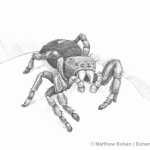
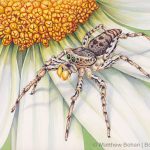
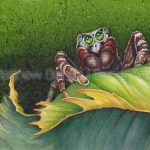
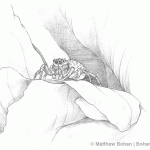
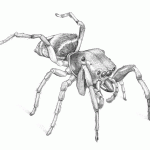
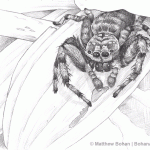
Leave a Reply